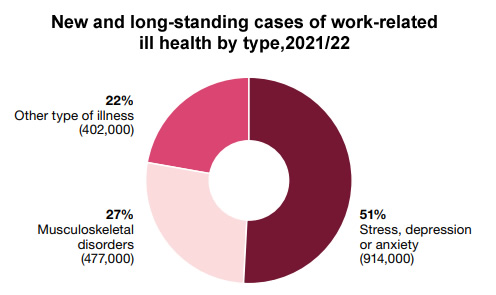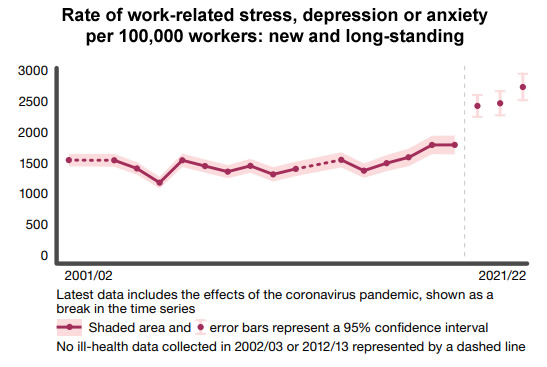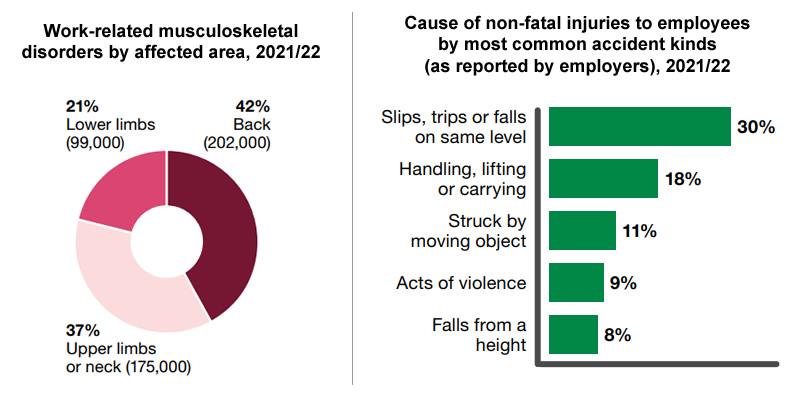Health and Safety Statistics 2022
The latest 2021/2022 statistics on work-related health and safety in Great Britain have recently been published by the Health and Safety Executive (HSE). In this blog post we delve into the details.
Key statistics
- 1.8 million working people suffering from a work-related illness, of which
- 914,000 workers suffering work-related stress, depression or anxiety
- 477,000 workers suffering from a work-related musculoskeletal disorder
- 123 workers killed in work-related accidents
- 565,000 working people sustained an injury at work according to the Labour Force Survey
- 61,713 injuries to employees reported under RIDDOR
- 36.8 million working days lost due to work-related illness and workplace injury
- £18.8 billion estimated cost of injuries and ill health from current working conditions (2019/20)
In 2021/22, 1.8 million working people suffered from a work-related illness, highlighting the continuing need for businesses to take action to prevent occupational ill-health. Not only is it a legal requirement to protect the health of your workers, improving your management of worker health and wellbeing also brings tangible business benefits.
Focus on work-related ill health
- 30.8 million working days were lost due to work-related ill health in 2021/22.
- Prior to the coronavirus pandemic, the rate of self-reported work related ill health and working days lost had been broadly flat. The current rate is considerably higher than the 2018/19 pre-coronavirus levels.
- Stress, depression or anxiety accounted for 51% of all new and long-standing cases of work-related ill health in the one year period 2021/2022. Musculoskeletal disorders accounted for 27% (477,000 cases).

Focus on work-related stress, depression or anxiety
- 914,000 workers suffering from work-related stress, depression or anxiety (new or long-standing) in 2021/22.
- 17 million working days lost due to work-related stress, depression or anxiety in 2021/22.
- Prior to the coronavirus pandemic, the rate of self-reported work related stress, depression or anxiety had shown signs of increasing. The current rate is continuing that trend, and is significantly higher than the 2018/19 pre-coronavirus levels. The effects of the coronavirus pandemic were found to be a major
contributory factor to work-related stress, depression or anxiety.

Focus on work-related musculoskeletal disorders
- 477,000 workers suffering from a work-related musculoskeletal disorder (new or longstanding) in 2021/22.
- 7.3 million working days lost due to work-related musculoskeletal disorders in 2021/22.
- Prior to the coronavirus pandemic, the rate of self-reported work related musculoskeletal disorders had shown a generally downward trend. The current rate is similar to the 2018/19 pre-coronavirus levels. In 2021/22 the effects of the coronavirus pandemic were found to be a contributory factor to work-related musculoskeletal disorders.
- The ‘back’ was the most common (42%) body area affected by work-related musculoskeletal disorders in 2021/22.
- ‘Handling, lifting or carrying’ was found to account for 18% of all non-fatal injuries to employees in 2021/22.

Focus on the financial cost to Britain
- £18.8 billion: Annual costs of work-related injury and ill health in 2019/20 *
- £11.2 billion: Annual costs of new cases of work-related ill health in 2019/20 *
- £7.6 billion: Annual costs of workplace injury in 2019/20
- *excluding long latency illness, such as cancer
Do your staff need health and safety training in manual handing, risk assessment, or DSE?
Since 1987 we’ve been trusted by some of the largest companies and organisations in the UK to train and protect their workforce. We are specialists in object manual handling and people moving and handling, risk assessment, DSE, and ergonomics.
If you want to do it right, and want to find out what makes OFI the best – get in touch with us now.








